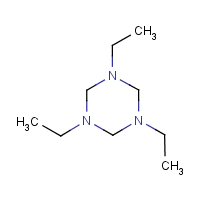1,3,5-Triethylhexahydro-s-triazine
Agent Name
1,3,5-Triethylhexahydro-s-triazine
Alternative Name
Vancide-TH
CAS Number
7779-27-3
Formula
C9-H21-N3
Major Category
Other Uses

Synonyms
Vancide-TH; 1,3,5-Triazine, 1,3,5-triethylhexahydro-; 1,3,5-Triethylhexahydro-1,3,5-triazine; Hexahydro-1,3,5-triethyl-s-triazine; Triethyl-trimethylenetriamine; s-Triazine, hexahydro-1,3,5-triethyl-; Hexahydro-1,3,5-triethyl-1,3,5-triazine; s-Triazine, 1,3,5-triethylhexahydro- (8CI); [ChemIDplus] UN2927
Category
Biocides/Disinfectants
Description
Colorless to light yellow liquid with an odor of formaldehyde; Formulated as soluble concentrate liquid; [Reference #1]
Sources/Uses
Used as biocide to control slime-forming bacteria and fungi in industrial adhesives, fuel/oil storage tanks, metalworking cutting fluids, paints (latex and aqueous slurries), rubber products, wet-end additives, and industrial processing chemicals; [Reference #1]
Comments
Corrosive; Occupational use may produce formaldehyde as an off-gas; [Reference #1] For the triazine herbicides, systemic toxicity unlikely unless large amounts are ingested; [EPA Pesticides, p. 121] A severe eye irritant; Causes zonal hepatitis in oral lethal-dose studies of mice; Causes other changes to liver and acute pulmonary edema in 14-day intermittent dermal study of rabbits; [RTECS] Combustible; Corrosive to skin; Causes corneal damage in rabbits; Harmful by inhalation; May release formaldehyde as an off-gas; Dermal studies have demonstrated skin absorption, hemolysis, and passive liver congestion; A moderate ingestion hazard based on animal studies; [R.T. Vanderbilt MSDS]
Reference Link #1
Biomedical References
Exposure Assessment
Vapor Pressure
15.7 mm Hg
Lethal Concentration
LC50 (rat) = 254 mg/m3
Explanatory Notes
The Guide in the Emergency Response Guidebook is for "Toxic liquid, corrosive, organic, n.o.s."
Adverse Effects
Hepatotoxin
Hepatoxic (a) from occupational exposure (secondary effect) or (b) in animal studies or in humans after ingestion
Dermatotoxin
Skin burns
Diseases, Processes, and Activities Linked to This Agent
Processes
Industrial Processes with risk of exposure: